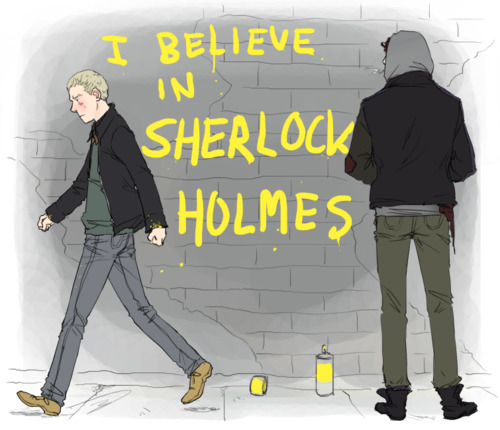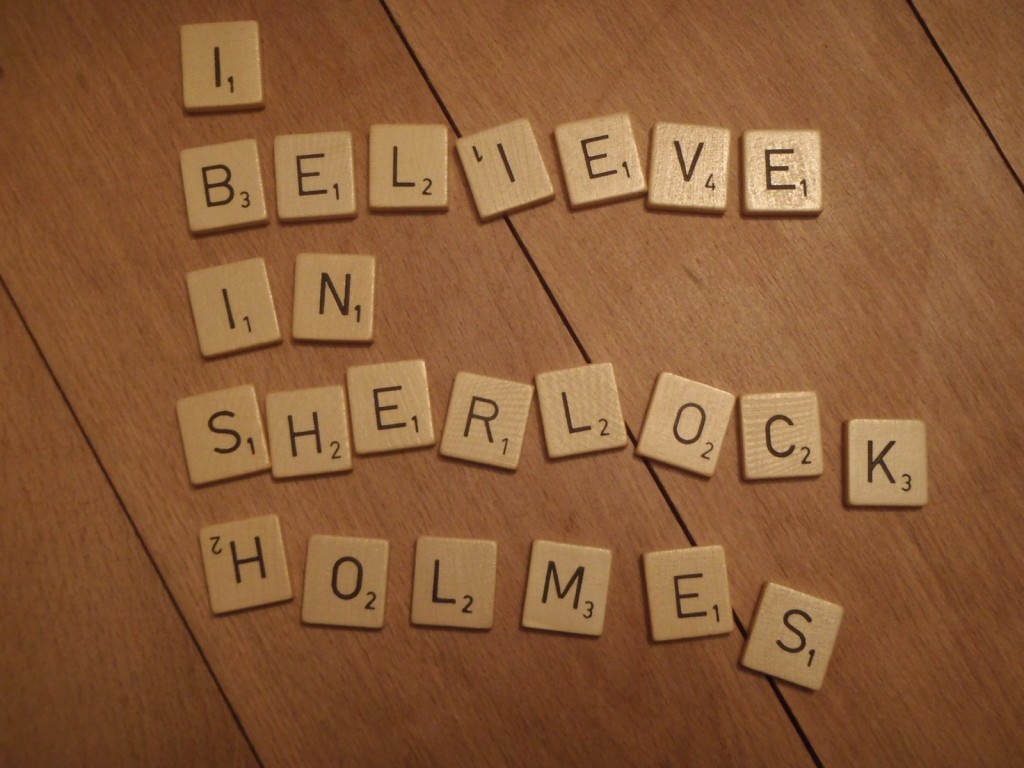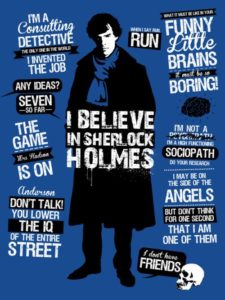“The Reichenbach Fall” by BBC television series Sherlock was the Season two, third and final episode of the season that was directed by Paul McGuigan and written by Mark Gatiss and Steven Moffat. Watson begins the episode at his therapist office stating to the audience that Sherlock Holmes, his best friend is dead. From there the episode is told in flashback. Sherlock is shown accepting accolades and media attention for solving cases. Moriarty simultaneously breaks into the Crown Jewels in the Tower of London, the vault of the Bank of England, and opens the Pentonville Prison cells. (Baker Street Wiki The Reichenbach Fall ). Moriarty writes “Get Sherlock” on the glass holding the Crown Jewels and is caught wearing the jewels. Sherlock testifies in Moriarty’s case and shares that he is a “criminal mastermind”. Moriarty doesn’t defend himself against the charges. The jury acquits Moriarty. Moriarty upon the acquittal drops by Sherlock’s apartment and states that he has a plan for Holmes. Watson learns from Mycroft that assassins have moved into nearby apartments on the street and in concerned for Sherlock’s safety. Moriarty sets in motion to kidnap the US Ambassador’s children in order to implicate Holmes and that Holmes has staged his cases. Sherlock is arrested by Gregson but Holmes and Watson escape. The assassins attempt to get the computer code from Sherlock given by Moriarty and die in the process. A journalist offers an expose on Sherlock and they break into her house where they meet Richard Brook, the false identity assumed by Moriarty. Richard Brook aka Moriarty will say that Sherlock paid him as an actor for the cases. Sherlock flees to Molly at the hospital asking for help. Watson pays Mycroft another visit to learn that Moriarty got the information about Sherlock from him. Watson gets word that Mrs. Hudson was shot and leaves Holmes at the hospital. Sherlock receives a text from Moriarty. They meet upon the Barts Hospital roof where Moriarty reveals that Sherlock needs to commit suicide to finish his plan. If Sherlock doesn’t commit suicide then, Sherlock’s friends will die. Holmes figures out that there is a fail-safe to the plan and when Moriarty realizes this, he kills himself. Watson rushes back to the hospital in time to receive a phone call from Sherlock stating that he is a fake and that the phone call is his note. Sherlock falls off the roof and lands on the street. Watson knocked down by a cyclist watches Holmes body retrieved by the hospital staff. The last scene is Mrs. Hudson and Watson in front of Sherlock’s grave where John asks Holmes to not be dead (Baker Street Wiki The Reichenbach Fall ). Dr. John Watson’s character updates his blog on June 16th with an entry that states, “He was my best friend and I”ll always believe in him.” (Watson). This references Sherlock’s fall and supposed suicidal death.
The episode adaptation contrasts with the original story in different ways. From changing Sherlock’s suicidal jump to his death from Bart’s Hospital to Moriarty’s fake identity name, Richard Brooke, a take on “Reichenbach Falls” where Moriarty and Sherlock plunge off the waterfalls in the original story. But in this episode the Reichenbach Falls is after Holmes’s famous case that he solved. The note left for Watson in the original story is changed to a phone call conversation between Sherlock and Watson where Watson can see Sherlock standing on the edge of Barts Hospital. Sherlock makes reference to suicide notes and that this is his suicide note, the phone call. It ends with Watson at Sherlock’s gravestone imploring that Holmes to be alive. This adaptation takes the cat and mouse chase from the original story and focuses it more on the Holmes and Moriarty rivalry presenting them as two sides of a coin. Cumberbatch plays Sherlock in this episode with a sadness which the character, Molly Hooper, picks up on and questions him. This aspect of Cumberbatch’s performance in this episode adaptation mirrors Doyle’s Sherlock in the Adventure of the Final Problem. Doyle hints at this with Sherlock’s comment, “I confess that it left an unpleasant effect upon my mind.” (Doyle, pg). Moriarty’s unpleasant effect on his mind reveals itself in the sadness and how he is motivated to protect his friends from Moriarty.
Surprisingly, the modern Sherlock fandom reacted similar to the Sherlockian fans when the Doyle story was released in 1893. Ashley Polasek (2012) argues Sherlockian fans engage in ‘The Game’ where Holmes and Watson are ‘real historical figures’ contained within the sixty original stories of the ‘Canon’ (Polasek 42). Thus, when Doyle decided to kill Sherlock Holmes in The Adventures of the Final Problem (1893) there was a public outcry for the character’s resurrection (Reed 289). The Sherlockian fandom has an active participatory nature to it since its origins and their outrage at Doyle manifested in multitudes of fans that wore black mourning bands, newspapers that covered Sherlock’s death with an obituary, and the Strand Magazine lost “over 20,000 subscriptions” (Fanlore.org/wiki/Sherlock_Holmes). The modern fandom’s reaction to the BBC Sherlock‘s “Reichenbach Falls” episode was a viral structure. This viral structure was in the form of the hashtag, #IBelieveinSherlock, created by the Tumblr user: Earlfoolish.tumblr.com aka Mika Hallor from Sweden living in England. Hallor states the viral guerilla arts campaign in response to the episode is:
” It’s a movement where Sherlock fans have made it their task to ‘whitewash’ Sherlock’s name after the lies spread by Moriarty in ‘The Reichenbach Fall’. In some ways, it is an ARG (alternative reality game) where the fans experience what it would have been like to be one of the Sherlock fans of the series…The movement aims at spreading flyers, stickers, graffiti, tweeting, blogging, and otherwise expressing their support for Sherlock” (Bostrom).
Figures (19-22) are examples of the campaign that were seen across the internet.

Figure 19:

Figure 20

Figure 21: Source Credit: http://alexia-muller.deviantart.com/art/I-believe-in-Sherlock-Holmes-329025122

Figure 22
The CBS television series, Elementary, presented during Season one for episode twenty-three, “The Woman,” directed by Seith Mann and written by Robert Doherty as their adaptation of Doyle’s “The Adventure of the Final Problem” (1893). Within the Elementary adaptation, the character of Irene Adler is Sherlock Holmes’s girlfriend. In this episode after going missing, Adler is found alive but suffering from symptoms similar to post-traumatic stress disorder or PTSD which Holmes attributes to Moriarty’s henchmen. Sherlock puts Joan Watson on the case while he attends to Irene. Watson follows the lead on a rare yellow paint found at Irene’s apartment. The paint trail leads to Duane Proctor and his brother Isaac Proctor. Both brothers claim innocence and Irene doesn’t recognize them. Irene questions Holmes on her absence and learns about his heroin addiction and relocation to New York City. Holmes agrees to run away with Irene. Isaac Proctor feeling betrayed goes after Holmes to kill him since Moriarty is obsessed with him. Sherlock noticing that Irene is missing a birthmark confronts her on it and accuses her of partnering with Moriarty. Isaac attacks Holmes but Irene saves Sherlock and is revealed to be Moriarty (Bakerstreet.wikia.com/wiki/The_Woman).
The Elementary episode, “The Woman/Heroine” (May 2013) beautifully captures the essence of Doyle’s original story. In contrasting the signs, Sherlock, Watson, Moriarty, the hate, pipe, coat, and Sherlock’s addiction through the adaptation can see how this adaptation transformed them. Jonny Lee Miller’s Sherlock in this episode is different than Doyle’s in his concern for Natalie Dormer’s Irene Adler. Watson opens the narrative of the story, “A Scandal in Bohemia” (1891) with the words, “To Sherlock Holmes she is always the woman” (Doyle, pg.). When Adler is found alive it shows how Sherlock and Irene are in a relationship. This moves beyond Doyle’s words which implied how highly Sherlock held Irene Adler, as the woman, in his esteem. The Elementary narrative follows Watson tracks down Moriarty and her henchmen more than Sherlock in the episode which expounds on Doyle’s original story where Watson is sharing the story in retrospect to clear Sherlock’s name. Interestingly, the episode also features a lunch scene between Watson and Moriarty after the reveal that Irene Adler is Moriarty and how each of the characters shares the mutual admiration of Sherlock Holmes. The episode’s reveal that Moriarty and Irene Adler are one and the same which adaptation is pushes further by choosing to portray Moriarty as a female character rather than Doyle’s male character. By changing genders of Moriarty and adding the Irene aspect to the character adds some sexual tension between Holmes and Moriarty. This episode also touches on the addiction in how Sherlock explains to Irene/Moriarty that when she went missing, he returned to his drug use.
Elementary choices to portray both Watson as Dr. Joan Watson and Irene/Moriarty as female transform the stories and characters to an extent. The characters’ transformation is inherent within the change as it can naturally add sexual tension between Holmes, Watson, and Irene/Moriarty. Also, it changes the dynamics of the relationship between Watson and Holmes. In Elementary, Watson is there to help keep Holmes sober and they become platonic friends in the process. To show a platonic friendship between a male and female character on television is refreshing. To add the sexual aspect between Irene/Moriarty and Holmes expounds on how they are symbiotic sides of a coin, both needing each other in the games that they play between each other. Doyle’s Holmes was dismissive of the female gender except for Irene and represents the Victorian man. So, for the character Moriarty, whom Holmes admires for intelligence, to turn the character into a female turns Doyle’s original signs on their head.
Works Cited
Baker Street Wiki The Reichenbach Fall . 2012. web. 21 September 2016.
Bakerstreet.wikia.com/wiki/The_Woman. 2013. web. 21 September 2016.
Bostrom, Mattias. “SherlockHolmes.se” Mike Hallor from Sweden started the movement #ibelieveinsherlock. 11 March 2015. 6 December 2015. web
Fanlore.org/wiki/Sherlock_Holmes. fanlore: Sherlock Holmes. 6 Feb 2015, web
Polasek, Ashley. “Winning the Grand Game: Sherlock and the Fragmentation of Fan Discourse” Busse, K. and Stein L. (Eds) Sherlock and Transmedia Fandom: Essays on the BBC Series. London. McFarland and Company. 2012 41-54, Print.
Reed, James. “Arthur Conan Doyle: the many faces of Sherlock Holmes” Advances in psychiatric treatment. 2012, 289-291 web.